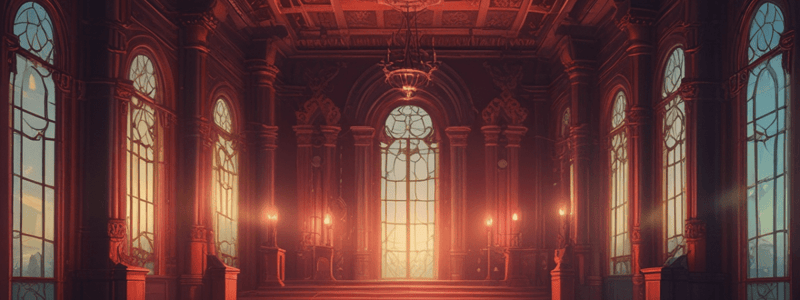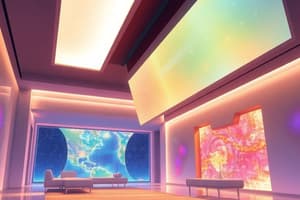Podcast
Questions and Answers
What is the light wheel primarily used for?
What is the light wheel primarily used for?
- Theater lighting and projection (correct)
- Video and computer graphics only
- Film and photography
- Music and sound design
What is the effect of placing warm and cool hues side by side?
What is the effect of placing warm and cool hues side by side?
- They influence their surroundings due to differing visual weights (correct)
- They cancel each other out
- They blend together seamlessly
- They remain unaffected by each other
What is the result of adding gray to a pure hue?
What is the result of adding gray to a pure hue?
- A shade is created
- The hue becomes more vibrant
- The saturation of the hue is reduced (correct)
- A tint is created
What is the purpose of dilution in color theory?
What is the purpose of dilution in color theory?
What is the term for a step of change between color samples?
What is the term for a step of change between color samples?
What happens when the descendant of two colors is arranged as if the parent colors were crossing each other?
What happens when the descendant of two colors is arranged as if the parent colors were crossing each other?
What is the relationship between yellow and orange in terms of value?
What is the relationship between yellow and orange in terms of value?
What is the effect of adding a complement to a saturated hue?
What is the effect of adding a complement to a saturated hue?
What happens to light when it passes from a fast medium to a slow medium?
What happens to light when it passes from a fast medium to a slow medium?
What is the typical source of interference?
What is the typical source of interference?
What is diffraction a special case of?
What is diffraction a special case of?
What is iridiscence an example of?
What is iridiscence an example of?
What does luminosity refer to?
What does luminosity refer to?
What does a high Color Rendering Index (CRI) value indicate?
What does a high Color Rendering Index (CRI) value indicate?
What is glare caused by?
What is glare caused by?
What is the result of the combined qualities of high light-reflectance and strong hue?
What is the result of the combined qualities of high light-reflectance and strong hue?
What is the term for the point at which an individual can no longer detect a difference between two close samples of color?
What is the term for the point at which an individual can no longer detect a difference between two close samples of color?
What is the result of using conflicting, unrelated colors in a design?
What is the result of using conflicting, unrelated colors in a design?
Which of the following color systems is based on the viewer's reaction to colors when they are placed next to each other?
Which of the following color systems is based on the viewer's reaction to colors when they are placed next to each other?
What is the term for the ability to detect differences between wavelengths of light?
What is the term for the ability to detect differences between wavelengths of light?
Which of the following colors is generally regarded as more receding?
Which of the following colors is generally regarded as more receding?
What is the term for a series of progressive intervals that are so close that individual steps cannot be distinguished?
What is the term for a series of progressive intervals that are so close that individual steps cannot be distinguished?
What is the result of using a range of combinations of colors in a design?
What is the result of using a range of combinations of colors in a design?
What is the term for the impression of transparency that can be achieved when two sets of color are joined by a third that is perfectly balanced between them?
What is the term for the impression of transparency that can be achieved when two sets of color are joined by a third that is perfectly balanced between them?
What is the primary organizing principle of the Munsell Wheel?
What is the primary organizing principle of the Munsell Wheel?
What is the significance of the vertical axis in the Munsell Wheel?
What is the significance of the vertical axis in the Munsell Wheel?
What is the name of the diagram developed by Johannes Itten?
What is the name of the diagram developed by Johannes Itten?
What is the significance of yellow in Itten's color star?
What is the significance of yellow in Itten's color star?
What is the shape of the teaching diagram used by Josef Albers?
What is the shape of the teaching diagram used by Josef Albers?
What is the characteristic of Albers' paintings?
What is the characteristic of Albers' paintings?
What is the purpose of Albers' color investigations?
What is the purpose of Albers' color investigations?
What is the significance of the neutral axis in the Munsell Wheel?
What is the significance of the neutral axis in the Munsell Wheel?
What is the connotation of violet in terms of social status?
What is the connotation of violet in terms of social status?
What emotion is invoked by overusing the color violet?
What emotion is invoked by overusing the color violet?
What is the symbolic meaning of black in terms of human emotions?
What is the symbolic meaning of black in terms of human emotions?
What is the effect of black on other colors?
What is the effect of black on other colors?
What is the nature of white in terms of color?
What is the nature of white in terms of color?
What is the negative connotation of white?
What is the negative connotation of white?
What is the positive connotation of violet?
What is the positive connotation of violet?
What is the common trait of black and violet?
What is the common trait of black and violet?
Study Notes
Color Theory
- The light wheel is the basis for theatrical lighting, projection, video, and computer graphics.
Color Temperature
- Cool hues (associated with blue) recede, suggesting sky, water, distance, foliage, and shadows, and are quiet, restful, and light.
- Warm hues (associated with red) advance, suggesting aggression, sunlight, heat, blood, arousal, and stimulation, and appear heavier than cool hues.
Color Properties
- Value: lightness and darkness of a color.
- Tint: a color with the presence of white, resulting in a lighter shade.
- Shade: a color with the presence of black, resulting in a darker shade.
- Saturation: intensity, brightness, or dullness of a color.
- Tone: addition of gray to a pure hue, reducing its intensity.
Color Relationships
- Dilution: changing a pure hue by lightening, darkening, or muting it with additives like white, black, gray, or its complement.
- Intervals: a step of change between color samples, creating an illusion when arranged as if crossing each other.
- Transparence: achieving the impression of transparency by joining two sets of color with a perfectly balanced third.
- Gradient: a series of progressive intervals that create a seamless transition between color differences.
Color Harmony
- Color harmony refers to the visual agreement of all parts of a work, also known as color chords.
- Types of color harmony include monochromatic, analogous, direct complementary, near-complementary, split complementary, double complementary, triadic, tetradic, and achromatic.
Color Systems
- Partitive color system: based on the viewer's reaction to colors when placed next to each other.
- Subtractive color process: mixing pigments together, seen in paintings.
- Interference, diffraction, and iridescence: optical phenomena that affect the way we perceive color.
Color Perception
- Luminosity: the ability of a color to reflect light, often characterized by watercolors, dyes, and markers.
- Luster: the state or quality of shining by reflecting light.
- Brilliance: the combined qualities of high light-reflectance and strong hue.
- Color Rendering Index (CRI): a measure of a light source's ability to reproduce colors accurately.
Color Theorists
- Albert Munsell: developed the Munsell Wheel, a three-dimensional color system with a trunk (value), branches (saturation), and a "tree" structure.
- Johannes Itten: developed a color sphere and "star" diagrams, placing yellow at the top due to its brightness and proximity to white light.
- Josef Albers: used a triangle diagram to investigate color interactions and contrasts, emphasizing the importance of few colors and strong contrasts.
Color Meaning
- Violet: associated with royalty, quality, luxury, and spirituality, but also with conceit, pomposity, mourning, and death.
- Black: the color of mystery, power, and sophistication, but also of death, emptiness, depression, and disapproval.
- White: the ultimate lightness, symbolizing purity, cleanliness, sterility, innocence, peacefulness, birth, and empowerment, but also surrender and cowardliness.
Studying That Suits You
Use AI to generate personalized quizzes and flashcards to suit your learning preferences.
Description
Learn about the concept of color temperature in theatrical lighting, including cool and warm hues, and their effects on the atmosphere.




